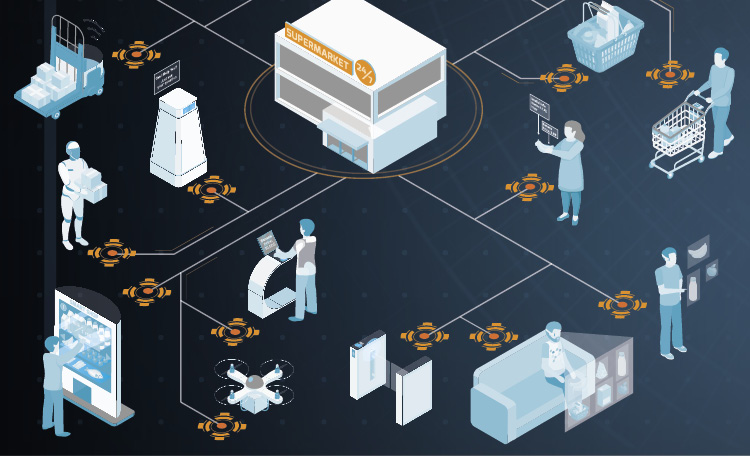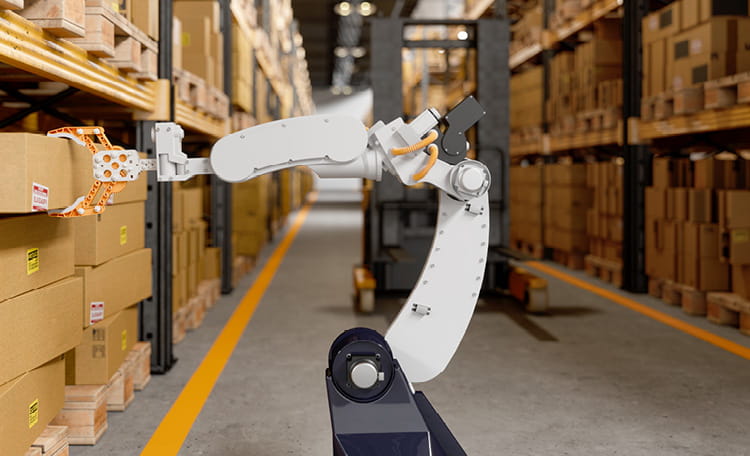
Digital sales, also known as e-commerce, have been growing steadily over the past several years. According to Internet Retailer, consumers worldwide spent nearly $3.46 trillion online in 2019, up from $2.93 trillion in 2018. In 2020, this number grew to an impressive $3.914 trillion, according to Business Insider, due to the global pandemic where a growing number of people shopped from home.
This uptick in sales has upped the ante for these companies to deliver faster, cheaper and better products—especially when customers are used to getting what they want, when they want it. After all, a shipping delay of even a day could result in the customer buying elsewhere online.
When a company clearly understands its SKU demand, order profile and customer profile, micro fulfillment1 is another option some companies are shifting to for efficiency and profitability. These micro fulfillment centers2 are typically smaller spaces located within a distribution center, warehouse or even existing store. When companies know exactly who they’re shipping to and what they want, they can yield a much better margin.
For companies to stay competitive while still giving customers what they want, they are going to have to rethink and accelerate their distribution and manufacturing models. What may have been in their five- or seven-year plan has become more immediate. Digital sales are all about customer interaction; service was the priority pre-pandemic and it remains so today. In addition to offering an omni-channel3 strategy, which provides a fully integrated and seamless shopping experience where customers can buy online and return in store or vice versa, the following are other tried and true strategies companies are adopting now for long-term success.
Shifting Fulfillment Tactics
With an uptick in digital sales, companies have gotten more strategic about how they are fulfilling orders online resulting in many stores shipping products directly from stores instead of using distribution centers. So, for instance, if a company has a national footprint of retail stores, it can ship directly from those stores, ultimately saving money. Levi’s, for example, traditionally has sold its jeans through distributors like Nordstrom or Walmart. This past year, it sold 30 percent of its products from its own retail stores in Q2 alone. This was a massive and profitable shift for the company. Apple will also start shipping in-stock products directly to consumers from its retail stores rather than its warehouses. And Best Buy has been testing limited SKUs on its store floor to make space for more fulfillment. The retailer added 90 ship-from-store hubs during the holiday season, supplementing the 250 ship-from-store locations it piloted last September. In addition, companies that had been using third-party sellers were starting to leave too much margin on the table as digital sales increased. By fulfilling orders themselves and shipping directly from stores, companies could make more money. Nike is a good example of a company that left a third-party seller in order to sell directly to its customers.
Focusing on Core Products and Existing Inventory
As a result of the pandemic, more companies have begun to ruthlessly look at their existing inventory, cutting SKUs where possible and focusing on core products instead. Companies have largely welcomed this practice, acknowledging that it leads to more profitable and leaner operations. Coca-Cola provides a good example of a company that decided to focus on fewer, bigger, better and stronger brands in its portfolio to free up resources and provide more organizational focus in the wake of COVID-19. The soft drink manufacturer is reevaluating its entire brand portfolio, carefully assessing 400 international, local and regional brands; more than half of the 400 brands have been deemed not scalable.
Regionalizing Operations
Pre-pandemic, many companies had already realized the flaw in dependency on one country or location for their supply chain. Shifting to manufacturing and sourcing from multiple locations allows for more agility and flexibility in their operations. And then the pandemic hit, and the need for regionalization4 accelerated. With countries in and out of lockdown, having the ability to rely on different parts of the world at different times has been key. Regionalization helps a company’s supply chain stay up and running, while avoiding risk on a global scale.
Although digital sales saw a major uptick during this pandemic, they are here to stay and will likely only become more prevalent in the years to come.
Automating Solutions
Automation is certainly not a new idea, but rather, the pandemic is simply accelerating plans that had already been in place. Labor had already been and continues to be scarce and expensive, and the pandemic has added a level of risk to in-person duties as well. Fortunately, automation reduces costs, saves time, improves business processes and has empowered employees during this crisis because it has freed them up to focus on other tasks. Although drones and robots aren’t the solution just yet—and won’t be until well after the pandemic—cobots5, or collaborative robots, are playing an important role when it comes to automation solutions. Home Depot and Walmart provide good examples of stores whose revenues have gone up during this pandemic, but costs have gone up even more to account for labor, transportation, shipping, etc. There are multiple strategies companies can take—and may already be taking—during this pandemic and beyond to stay competitive while giving customers the quality service they demand and expect. Whether it’s shifting fulfillment tactics or automating solutions, companies should pick a strategy and stick with it if they want to be successful. Although digital sales saw a major uptick during this pandemic, they are here to stay and will likely only become more prevalent in the years to come.
1MICRO-FULFILLMENT: A strategy that retailers use to make the fulfillment process more efficient—from receiving an online order to packing it and in some cases offering last-mile delivery. The approach aims to take the speed of localized, in-store pick-up and combine it with the efficiency of large, automated warehouses.
2MICRO-FULFILLMENT CENTER (MFC): MFCs are automated fulfillment centers with footprints typically ranging from 10,000 to 20,000 square feet, with some as small as 5,000 square feet. They can be cohoused inside an existing store or placed in a smaller warehouse space in an urban location.
3OMNI-CHANNEL: Omni-channel retail (or omni-channel commerce) is a multichannel approach to sales that focuses on providing seamless customer experience whether the client is shopping online from a mobile device, a laptop or in a brick-and-mortar store.
4REGIONALIZATION: The explosive growth of domestic and international digital sales has driven retailers to create more regionalized distribution networks in order to stock products closer to the end customer and simplify the process of product returns.
5COBOTS: Cobots, or collaborative robots, are robots intended for direct human robot interaction within a shared space, or where humans and robots are in close proximity. Cobot applications contrast with traditional industrial robot applications in which robots are isolated from human contact.



